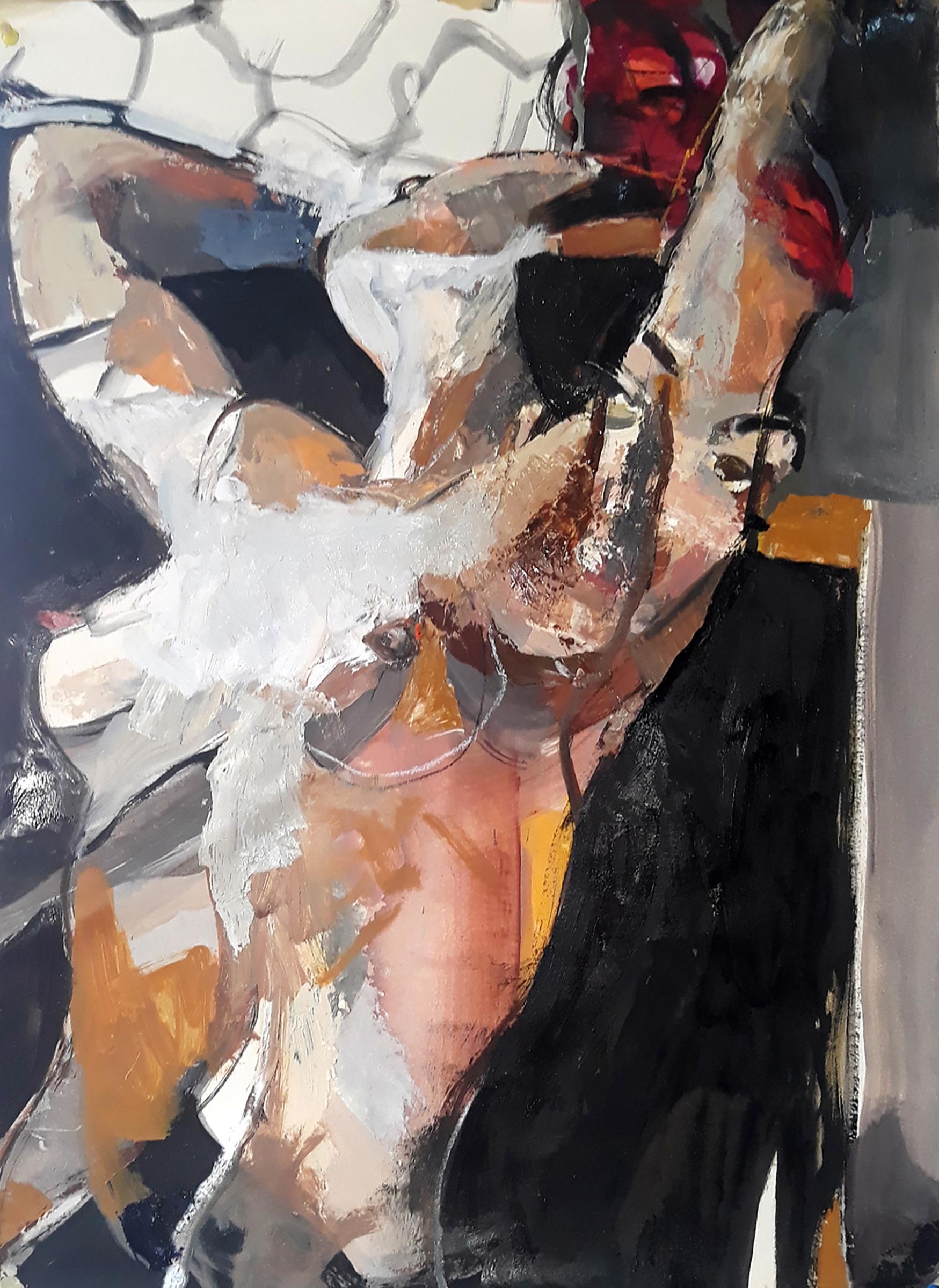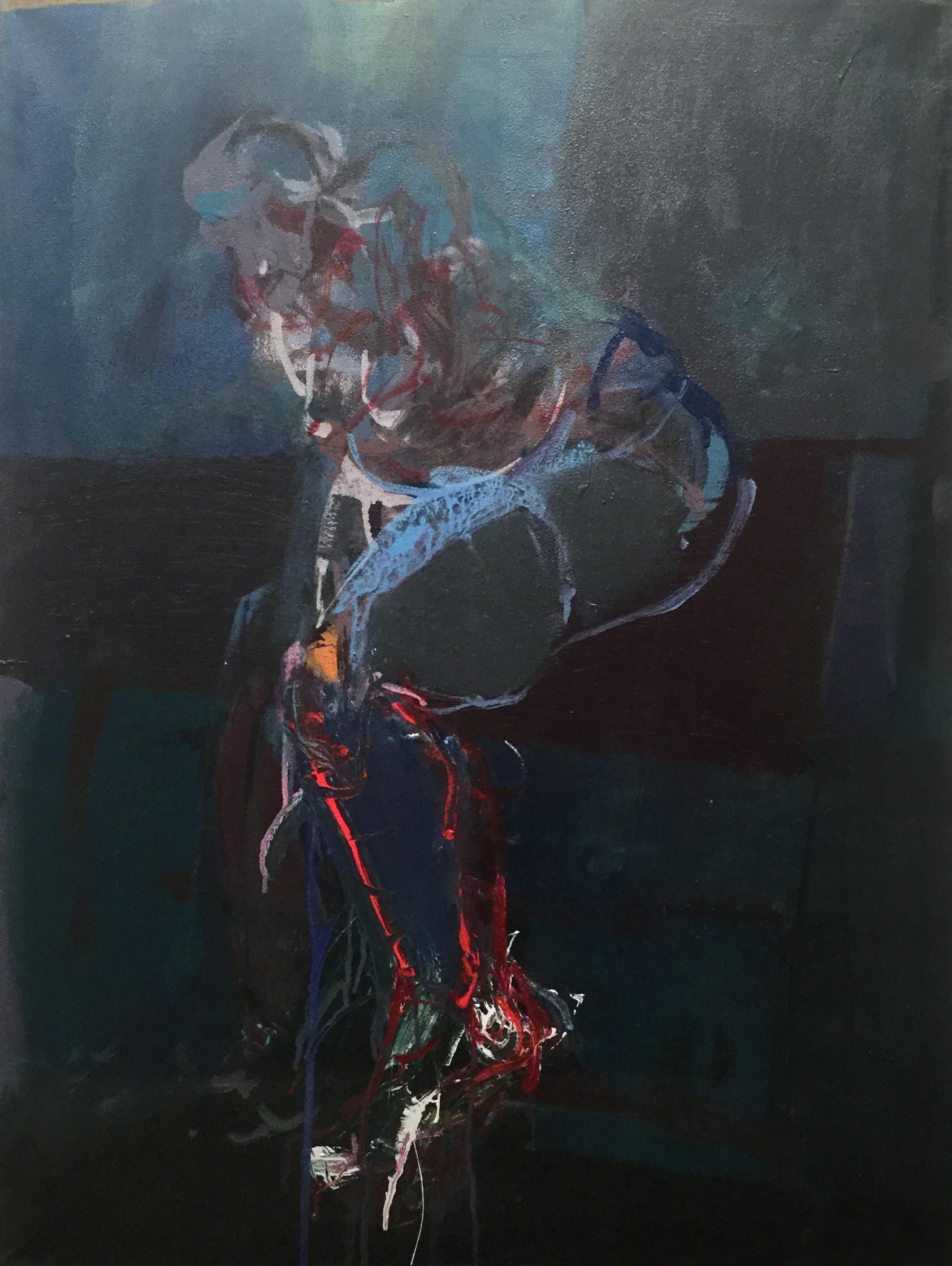Items Similar to Fish and Bicycles # 12
Want more images or videos?
Request additional images or videos from the seller
1 of 5
Bruce AdamsFish and Bicycles # 121988
1988
About the Item
An original oil on paper by contemporary artist Bruce Adams from his Fish and Bicycles series. This work is currently part of an exhibition at Benjaman Gallery "Over the Fence".
This piece comes framed in an archival natural wood frame presentation.
The Fish and Bicycle series employs a similar strategy as my Men at Work series. This time the subject matter includes both men and women (exhibited in pairs) representing a range of gender identities. The title is derived from Irina Dunn’s witty statement (often erroneously attributed to Gloria Steinem), “A woman needs a man like a fish needs a bicycle.” The metaphoric use of a variety of bicycles and fish add layers – figuratively and literally – to the complex relationship between the figures when viewed collectively.
These works examine the nature of masculinity and femininity in a society where an all-pervasive concept of beauty and power permeates popular culture and art in ways that create self-perpetuating societal myths. With these paintings I beg the question: “Just what is male and female?”
- Creator:Bruce Adams (1952, American)
- Creation Year:1988
- Dimensions:Height: 30 in (76.2 cm)Width: 22 in (55.88 cm)
- Medium:
- Movement & Style:
- Period:
- Condition:
- Gallery Location:Buffalo, NY
- Reference Number:1stDibs: LU13921321903
About the Seller
4.9
Platinum Seller
These expertly vetted sellers are 1stDibs' most experienced sellers and are rated highest by our customers.
Established in 1970
1stDibs seller since 2015
2,381 sales on 1stDibs
Typical response time: 1 hour
- ShippingRetrieving quote...Ships From: Buffalo, NY
- Return PolicyA return for this item may be initiated within 10 days of delivery.
More From This SellerView All
- UntitledBy Jackie FelixLocated in Buffalo, NYAn original expressionist painting by American female artist Jackie Felix.Category
1980s Expressionist Nude Paintings
MaterialsCanvas, Oil
- Research & Development Figural 1 & 2By Bruce AdamsLocated in Buffalo, NYA pair of paintings by American contemporary artist Bruce Adams. Art is the R&D for culture. Artists Conduct the R&D for society. In the late twentieth century painting was rejec...Category
1990s Expressionist Figurative Paintings
MaterialsAcrylic, Canvas
- Research & Development Figural 3 & 4By Bruce AdamsLocated in Buffalo, NYA pair of paintings in one singular frame presentation by American contemporary artist Bruce Adams Art is the R&D for culture. Artists Conduct the R&D for society. In the late tw...Category
1990s Expressionist Figurative Paintings
MaterialsAcrylic, Canvas
- Biology 101By Jackie FelixLocated in Buffalo, NYAn original oil on un-stretched canvas by Jackie Felix, currently featured in the exhibition at Benjaman Gallery "Over the Fence". Jackie Felix (1929-2009) earned her Bachelor of ...Category
1980s Abstract Expressionist Figurative Paintings
MaterialsCanvas, Oil
- End of October/Beginning of NovemberBy Jackie FelixLocated in Buffalo, NYAn original oil on un-stretched canvas which was featured in the artist's retrospective exhibition at The Burchfield Penney Art Center. Jackie Felix (1929-2009) earned her Bachelo...Category
1980s Abstract Expressionist Figurative Paintings
MaterialsCanvas, Oil
- Puppet With the Green Eyes Contemporary Surrealist Painting Ellen SteinfeldBy Ellen SteinfeldLocated in Buffalo, NYAn original modern surreal oil painting by American artist Ellen Steinfeld titled, "Puppet with the Green Eyes"Category
1980s Surrealist Nude Paintings
MaterialsCanvas, Oil
You May Also Like
- Buried Mistake expressionist figurative nude active warm and cool colorsBy Tom BennettLocated in Brooklyn, NYExpressive nude figure, movement, powerful color and texture, abstract brushworkCategory
2010s Expressionist Nude Paintings
MaterialsPaper, Oil Crayon, Oil
- Seated NudeBy Helge HelmeLocated in New York, NYAxel Henry Helge Helme (1894 Roskilde, Denmark 1987), Seated Nude, circa 1930, oil on canvas, original frame Son of a merchant, Helge Helme was admitted ...Category
20th Century Expressionist Nude Paintings
MaterialsOil, Canvas
- "Aquarius" Oil Painting 31.5" x 51" inch by Sergey DolmatovLocated in Culver City, CA"Aquarius" Oil Painting 31.5" x 51" inch by Sergey Dolmatov Year: 2014Category
21st Century and Contemporary Expressionist Figurative Paintings
MaterialsCanvas, Oil
- Female Nude Sitting Figure - Expressive Oil PaintingBy Agata Czeremuszkin-ChrutLocated in Salzburg, ATAgata Czeremuszkin-Chrut was born in 1983 in Czestochowa, Poland. She graduated from the Academy of the Fine Arts in Wroclaw (2008) with the Master degree in Painting. In 2007 she st...Category
2010s Expressionist Nude Paintings
MaterialsOil, Canvas
- Nandor Vagh Weinmann, Oil on cardboard, Naked Back, 1930sLocated in Saint Amans des cots, FROil on cardboard by Nandor VAGH WEINMANN (1897-1978), France, 1930s. Naked back. With frame: 64x56 cm - 25.2x22 inches ; without frame: 46x38cm - 18.1x15 inches. 8F format. Signed "Nandor V. Weinmann" lower left. In its Montparnasse frame. Very good condition. Born October 3, 1897 in Budapest, Nándor is the older brother of Elemer and Maurice Vagh-Weinmann. He came to Paris to present his work in 1931. He died on December 12, 1978 near Montereau (Seine-et-Marne) following an automobile accident. He is the most colorful of the three “expressionist” brothers. Painter of figures, landscapes, especially open mountains, and bouquets in bright colors. He is also a religious painter and then finds the tragic condition. Born in BUDAPEST on October 3, 1897, Nandor Vagh Weinmann belongs to a profoundly artistic people. Living in the heart of Central Europe where they came from Asia a millennium ago, the Hungarians have preserved a strong ethnic individuality whose mark is their very synthetic, non-Indo-European language. Resistant to secular invasions, they have kept the virtues of a very ancient humanity that have become rare in our modern world, especially since their way of life has remained essentially rural until today. In the arts they know how to express a generous, extreme sensibility and by the poetic verb, by the musical rhythms and also by a popular art of a richness, an exceptional harmony. Until the age of thirty-four, during the decisive years of childhood and youth, Nandor Vagh Weinmann was intimately imbued with popular life and the soul of Hungary. From the capital where his father was a jeweler and had a family of ten children, Nandor was the fifth, he knew first of all the suburbs, the populated districts, the rigors in winter of the cold and the snow. A very mobile existence made him acquainted with all of Hungary, from the Danube to Transylvania, its infinite plains and its wild mountains, its immense villages with ample low houses, and its towns which are still immense villages. The painter is passionate about rustic works, harvest scenes, beautiful folk costumes. Coming into direct contact with the peasants, he learned to know their soul. These contacts gave the artist a direct feeling for popular life and soul, as Millet once understood the peasants of Barbizon and Normandy whose existence he shared. What fascinated Nandor Vagh Weinmann above all were the festivals which enlivened the dreary life of the countryside, the circuses, the merry-go-rounds, the gypsies unleashing orgies of music, light and color. In the party, and especially the Hungarian party, the whole soul of a people, all its energy, its need for movement, for intensity, is expressed in its pure state and realizes the primary and essential form of what is called beauty. And as if melted at the party, there is the infinite steppe where herds of horses and oxen circulate where terrible storms sometimes roar where the seasons unfold their grandiose splendours. The young Nandor Vagh Weinmann nourishes his sensitivity to his inexhaustible shows, both eternal and always new, a sensitivity which very early declared itself that of a painter. Since the age of fourteen he painted, and since then he never stopped doing it. Two of his brothers Maurice, two years his junior, who had a remarkable career similar to that of Nandor and later Elemer who became Maurice's pupil, also devoted themselves to painting, despite family obstacles. And the three brothers united by a common passion worked together in Hungary and later in France. Painting was so much in the blood of the family, as in the past among the Veroneses, the Breughels, the Lenains, the Van Loos and so many other artistic dynasties, that three sons of the Vagh Weinmanns became painters in their turn. One of these, Emeric, son of Nandor, today occupies an important place in the contemporary school. Nandor, at fifteen, was a pupil of the Academy of Fine Arts in Budapest where he worked diligently, then at that of Vienna. He painted many portraits, but also landscapes, compositions and, by his relentless work, managed to live from his brush, although married very young and having to overcome many hardships. He therefore knew the hardships and miseries of life. These strongly impregnated his vision as an artist and explain the thrill of humanity that runs through all his work. A particularly moving experience was reserved for him at the age of twenty. In the hospitals of Budapest he had to paint extraordinary cases, operations, frightful wounds, the deformations to which our poor body is subjected by traumas and physiological decompositions. In these circumstances, it is not a question of gratuitous art, of formal research but of immediate, authentic expressions of our flesh and our being. We know that Breughel Velázquez and Goya had been haunted by the sight of cripples and of madmen Géricault by that of corpses. But life is ultimately stronger than anything, and it is life that Nandor Vagh Weinmann has passionately observed and translated through all the places where he has always painted on nature. Nothing stopped him. It happened to him to paint, for example in front of the mill of Linselles by a weather so cold, that nobody could stay outside, and that he did not leave the place before having finished his work. Because he works constantly on the ground, under the sky, in the silence he loves. His reputation is established. He exhibited at the national fair in Budapest, in the big cities of Hungary Szeged, Szombathely, Veszprém, Kaposvar. In 1931, like all artists in the world, he came to France. But unlike the others, he did not settle in Paris. Because Nandor Vagh Weinmann does not belong to this group of cosmopolitans that we call the School of Paris. He settled in Toulouse, where he remained for a long time with his brothers, and traveled throughout France, eager for new ties, exhibiting in the most diverse cities, in Bordeaux, Marseille, Lyon, Agen, Bayonne, Dax, Tarbes, Grenoble, Nice, Cannes, Strasbourg, Mulhouse, Colmar, Lille. He even crossed borders. He was in Saint Sebastian, in Geneva, and once in Egypt in 1927 where he painted King Fouad...Category
1930s Expressionist Figurative Paintings
MaterialsOil, Cardboard
- Edouard Goerg, Les 3 Brunes, Large Oil on Canvas, 1955By Edouard GoergLocated in Saint Amans des cots, FRLarge oil on canvas by Edouard GOERG (1893-1969), France, 1955. LES 3 BRUNES. With frame : 114x95cm - 44.9x37.4 inches ; without frame : 92.2x73 cm - 36.3x28.75 inches. Format 30F. S...Category
1950s Expressionist Figurative Paintings
MaterialsCanvas, Oil

